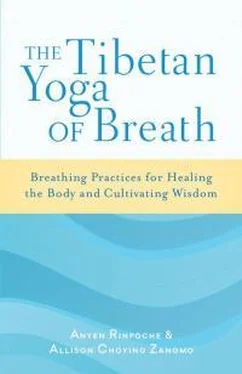Throughout history, the majority of the great yogis in the world, no matter what other practice they were training in, accompanied their practice with an aspect of wind energy training, or breath yoga. Although the specific techniques of breath yoga used by these yogis may have been different, they each had the common result of self-healing the body and mind and the achievement of longevity. Their lives imply that the qualities of physical and mental well-being are directly connected to wind energy training.
Of course, we may not all be able to attain the realization of a buddha or become a great sage in this lifetime, but wind energy training can still benefit us tremendously. Wind energy training not only results in extraordinary wisdom and realization, as described above, but it also results in ordinary worldly wisdom. When we have the qualities of calm and relaxation in body, speech, and mind, we are able to accomplish more, and with better-designed plans. We make clear and thoughtful decisions and have more harmonious relationships. We avoid doing things that are at odds with our personal goals and integrity, and do not sabotage our own growth. We avoid making impulsive decisions, or speaking impulsive words, ones we may regret later. When we lack chaos on the inside, the world outside reflects our sense of inner harmony.
If we train in wind energy, each of us has the ability both to discover a more joyful life here and now and, ultimately, to cultivate wisdom.
2
Working with Breath and Neurotic Mind
THE MIND’S FUNDAMENTAL nature is not neurotic and emotionally afflicted. It is of limitless kindness and compassion. However, because we have become so used to the experience of mental and emotional instability, we rarely catch a glimpse of this fundamental nature. In this chapter we will get a sense of how our habitual and unexamined patterns of thought are directly linked to our breathing, and drive our reactions in life, leading to happiness or unhappiness. We will also learn about how wind energy influences our state of mind moment by moment.
SELF-ATTACHMENT AND SELF-ACCEPTANCE
From the point of view of the general Buddhist teachings, the basis for neurotic mind, or the dualistic mind that is overpowered by emotions and thoughts, is self-attachment. It can also be called self-cherishing . We may feel that the word neurosis only applies to extreme emotions and thought patterns. However, from the point of view of Tibetan Buddhism, neurosis is any trace of self-attachment or afflictive emotion. Until we completely realize the nature of wisdom, we all possess neurotic mind.
True awareness of our own self-attachment and self-cherishing is elusive. We often do not feel like we love ourselves at all. In fact, many of us feel we do not even like ourselves. We may be inclined to self-deprecation, insecurity, and feeling that we are never good enough. However, feelings of insecurity and undervaluing ourselves like this can be self-attachment in disguise. In other words, they can cause us to turn inward and be focused on ourselves, rather than focusing on supporting others and the greater community. This lack of confidence and disparaging of ourselves can make us emotionally and spiritually unavailable; we become isolated and distant from our friends and family, failing to offer them support in their time of need.
Because these feelings are so prevalent within our culture, the idea of self-acceptance has come to the forefront of emotional and spiritual healing. And self-acceptance, when it is not self-attachment in disguise, is also an important part of the Buddhist teachings. Accepting ourselves for who and what we are right now helps us make changes in our lives; we can understand both our capabilities and our limitations and ultimately transcend them. We can let go of the past and focus on what we are doing right now. With an attitude of self-acceptance, we can forgive ourselves for mistakes made in the past and the part we played in those situations.
Often, we focus on “what is wrong with us,” but true self-acceptance is not just about accepting our shortcomings. All human beings possess many wonderful qualities as well. From the point of view of the Buddhist teachings, we all have the ability to be loving and compassionate. We all have the ability to change and improve on the qualities and abilities we have now. We are all worthy of the love and affection of others. This is part of our underlying nature, which the Buddhist teachings describe as “basic goodness.” This basically good nature is something that all beings possess simply as a result of being alive. The Buddhist teachings give the example that even terrifying, carnivorous animals such as lions and tigers are basically good, because they care for and would even give their lives for their offspring.
The Buddhist teachings also state that we all have what is called Buddha Nature . Buddha Nature is something that dwells within all of us: it is the mind’s potential to express wisdom. Wisdom here refers not only to the qualities of worldly intelligence and knowledge that make us adept and successful at dealing with life’s problems, but it also refers to a nondual, altruistic state of mind that is not limited in any way. Such a mental state is difficult to imagine because it is completely beyond our ordinary experience. But from the point of view of the Buddhist teachings, we do not need to do anything to possess this quality. Like basic goodness, Buddha Nature is something we have inside of us naturally, simply because we are alive.
STATE OF MIND IS AN EXPRESSION OF THE BREATH
We have a tendency to think that what we see in the world outside of us is actually, objectively real. But the world that we see outside of us is a reflection of our own minds. We may question the truth of this statement, but it does make sense when we reflect on our past experiences. In hindsight, we realize that different choices were available to us, even though we could not see those choices then. As the saying goes, “If I had known then what I know now . . . .” We have all reflected on the past in this way, and this normal thought pattern that we all engage in demonstrates that our experiences are indeed subjective, not objective. Everything that we experience is colored by the mental ideas, filters, perceptions, and beliefs that we have at any given moment. Although we may have brief moments of calmness and clarity, the great majority of our time is spent reacting to situations and people around us based on how we feel. In the Tibetan Buddhist tradition, it is taught that how we feel and our mental state are directly related to how we breathe, and the quality of our wind energy.
Logically speaking, this connection between our state of mind and our breathing seems to hold some merit. Most of us are aware that when the breath is relaxed, the mind and temperament are relaxed. But how does the wind energy push those deep thoughts and emotions to the surface? As it turns out, we are much more familiar with this phenomenon than we might expect.
One example many of us are familiar with is the strong urge to act out our emotions when we are upset. Through the lens of Tibetan Buddhist philosophy, this is a direct result of unstable wind energy. For example, when we feel agitated, angry, or impatient, hot wind energy arises and gathers below the rib cage around the heart; we often express anger at whoever is in front of us, regardless of whether that person is connected to how we feel at all. We blurt out more than we mean to say because this accumulated wind energy in our chest makes us incapable of keeping our feelings inside and making decisions about what we would like to communicate. Likewise, when sadness and despair arise, we can become overwhelmed. We start to feel numb and disconnected from others or ourselves, even failing to take care of our basic needs. The feeling of anxiety, or mental obsession, is also fueled by wind energy. When we are overcome by this expression of wind energy, we may feel that we need to do something, anything, no matter what it is. As a result, we often make rash and impulsive decisions that we later regret. In these cases, imbalance in the wind energy leads to an imbalance in the mind, which manifests as imbalance in ourselves, our environment, and our relationships. The outer is a reflection of the inner.
Читать дальше












